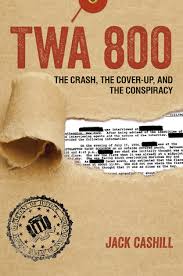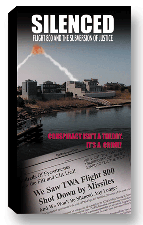Dr. Ford’s Willfully Tangled Web
![]()

Order Jack Cashill's latest book, TWA 800: The Crash, the Cover-Up, and the Conspiracy
![]()

About Silenced: Flight 800
and the Subversion
of Justice (DVD) -
-Buy the Silenced DVD-
![]()
© Jack Cashill
October 16, 2018 - AmericanThinker.com
It was not Shakespeare, but Sir Walter Scott who wrote, "O, what a tangled web we weave when first we practise to deceive!” During her testimony before the Senate Judiciary Committee on September 27, Christine Blasey Ford proved that Scott’s axiom is at least as valid today as it was two centuries ago.
There is likely a core of truth to the story Ford told on September 27. The evidence, however, fully exonerates Justice Brett Kavanaugh. It suggests instead that the 18-year-old Ford attended an afternoon event in 1985 at which four young men from an elitist boy’s school physically abused and sexually intimidated her, after which she drove herself home.
Although Ford’s testimony was littered with non-material deceptions—her alleged fear of flying stands out among them—the ones that matter have to deal with the who and when of her assault.
The first weave in her web occurred on July 6, 2018, when Ford contacted the Washington Post’s encrypted tip line. In her message, Ford told the Post of an assault by Brett Kavanaugh in the “mid-80s.”
This date jibes with the notes from a 2013 therapy session, portions of which Ford later shared with the Washington Post. Citing the therapist’s notes, the Post’s Emma Brown reported on August 16 that Ford was in her “late teens” when the attack occurred. Ford was born in November 1966. In the mid-80s summer of 1985 she was 18.
Those same therapist notes indicate that four boys were involved in the assault and that these boys went on to become “highly respected and high-ranking members of society in Washington.” According to Ford, the therapist made an “error” in recording “four” boys.
Mark Judge first surfaced as a participant in Ford’s July 6th text to the Washington Post. In a July 30 letter to Sen. Diane Feinstein, Ford added detail. “Brett Kavanaugh physically and sexually assaulted me during high school in the early 1980's,” she wrote. “He conducted these acts with the assistance of his close friend, Mark G. Judge.” From this point on, Judge would find himself inextricably trapped in Ford’s increasingly tangled web.
In the Feinstein letter, the four boys cited in the therapist notes became “me and 4 others,” one of the others being her female friend, Leland Ingham Keyser. Ford also introduced a detail that would provide the key to untangling the timeline on which she ultimately settled.
“I have not knowingly seen Kavanaugh since the assault,” Ford wrote. “I did see Judge once at the Potomac Village Safeway, where he was extremely uncomfortable seeing me.” Curiously, Ford signed the letter to Feinstein “Christine Blasey.”
Ford admittedly wrote the Feinstein letter while she was visiting friends in Rehoboth, Delaware. She told prosecutor Rachel Mitchell during the committee hearing that she wrote it by herself. Living in Rehoboth, however, was lifelong Ford friend Monica McLean, pictured here at a Rehoboth wine tasting event and here at the Senate Judiciary hearing.
An attorney, McLean worked for the FBI and Department of Justice in varying capacities from 1992 to 2016. She first surfaced in the media as one of the signatories from the Holton Arms class of 1984 supporting Ford. In her testimony to the Senate committee, Ford made no reference to McLean and remained disingenuously vague about who referred her to the FBI polygrapher and how she came to choose her attorneys.
On October 2, Brian Merrick, a former long-term boyfriend of Ford, sent a sworn letter to the House Justice Committee claiming he witnessed Ford coach McLean on how to pass a polygraph test when she was applying for her DOJ job. McLean denied the claim but only to the media. Ford denied that she had ever coached anyone on a polygraph under oath.
On October 5, the Wall Street Journal reported that Ford’s friend Leland Keyser told the FBI that she experienced pressure from McLean to revisit her account of the 1982 party in question. Like all the named party-goers, Keyser had no memory of the event at all. For their part, the major media have done nothing with the McLean angle save to suppress it. The fact that Leland attended the Judiciary hearing with Ford did not intrigue them.
In her summary report of the hearing, Rachel Mitchell made one critical observation about the date of the attack. Wrote Mitchell, “While it is common for victims to be uncertain about dates, Dr. Ford failed to explain how she was suddenly able to narrow the timeframe to a particular season and particular year.”
As Mitchell knew, there was an obvious answer to this question. Mark Judge provided it in his 1997 book, Wasted: Tales of a Gen X Drunk. As of July 6, if Ford had read the book, she had not yet started to mine its useful details. She could narrow her timeline no finer than “mid-80s.” By July 30, Ford was saying “early 80s” and definitively putting Judge at the scene.
Early in her questioning by Mitchell, Ford said of Judge, “I did see Mark Judge once at the Potomac Village Safeway after the time of the attack. And it would be helpful with anyone’s resources if — to figure out when he worked there.” She and her allies knew when Judge worked there. It was the summer of 1982 when Ford was 15.
Later, Democratic Sen. Dick Durbin asked Ford, “Would you please describe that encounter at the Safeway with Mark Judge and what led you to believe he was uncomfortable?”
Ford answered Durbin’s question with a suspicious amount of detail. She told of how she went with her mother to the to “the Potomac Village Safeway . . . on the corner of Falls and River Road.” Embarrassed to be seen with one’s mom at that age, she went in a separate door and there saw Judge “arranging the shopping carts.” Ford said hello to him, and his face was “white and very uncomfortable.” She added later, “he looked a little bit ill.”
On the same day as the Judiciary hearing, The Washington Post’s Philip Bump wrote an article with the impressively self-deceptive headline, “Mark Judge’s book validates Christine Blasey Ford’s timeline of the alleged Kavanaugh assault.”
Bump had obviously read the book before the hearing. He posted extensive quotes from it on the same day as the hearing. Ford had merely recycled the detail Judge provided in his book.
“It was the summer before senior year” Judge wrote of his time at Safeway. His job at Safeway was to manage the “grocery baskets” that people would leave in front of the store. “Invariably I would be hungover — or still drunk — when I got to work at seven in the morning,” Judge added, “and I spent most of the first hour just trying to hold myself together.” It was no wonder he “looked a little bit ill.”
If the Post had read the book and the Senate Democrats had read the book—Sen. Leahy read a quote directly from it—how could Ford and her allies not have read it? Wasted provided them all the details they needed “to narrow the timeframe.”
Had Ford not laid on the excessive detail, she might have made the sudden narrowing seem legitimate. It wasn’t. One has to wonder whether Ford implicated Judge in the attack because the book’s revelation left him—and Kavanaugh by extension--vulnerable to charges of wanton, drunken behavior.
In fact, Judge had no idea he was being implicated in the assault until the New Yorker’s Ronan Farrow informed him several days before Ford went public on September 16. In an interview on September 13 with the Weekly Standard, Judge “strongly” denied any such incident. "It's just absolutely nuts,” he said. “I never saw Brett act that way."
The one hole in Ford’s testimony that troubled most observers, even friendly ones, was her failure to recall how she got home from a suburban neighborhood miles from her house in the era before cellphones. “I do not remember,” she told Mitchell, “other than I did not drive home.”
Ford knew she did not drive home because in the summer of 1982, the summer Judge worked at Safeway, she was too young. “I did not drive home from that party or to that party, and once I did have my driver’s license, I liked to drive myself,” she added later.
Drive herself--that is almost assuredly what 18-year-old Christine Blasey did on that mid-80s day. With a one-piece bathing suit on under her clothes, she was not coming from diving practice as she testified, but likely on her way to practice or to a pool party. Why put her clothes on over a wet suit? Something apparently happened that day. Four young men, now all “highly respected and high-ranking members of society in Washington,” abused her.
Many things have been said about Mark Judge, a surprisingly good writer who has been struggling with addiction most of his adult life, but no one has called him a highly respected, high ranking member of Washington society.
Republicans need to set this story straight before it gets set in stone the way Anita Hill’s equally mendacious story has. “Judge, do you — do you believe Anita Hill?” Sen. Richard Blumenthal asked Kavanaugh during the hearing. It is a good thing Kavanaugh did not have time to answer.

